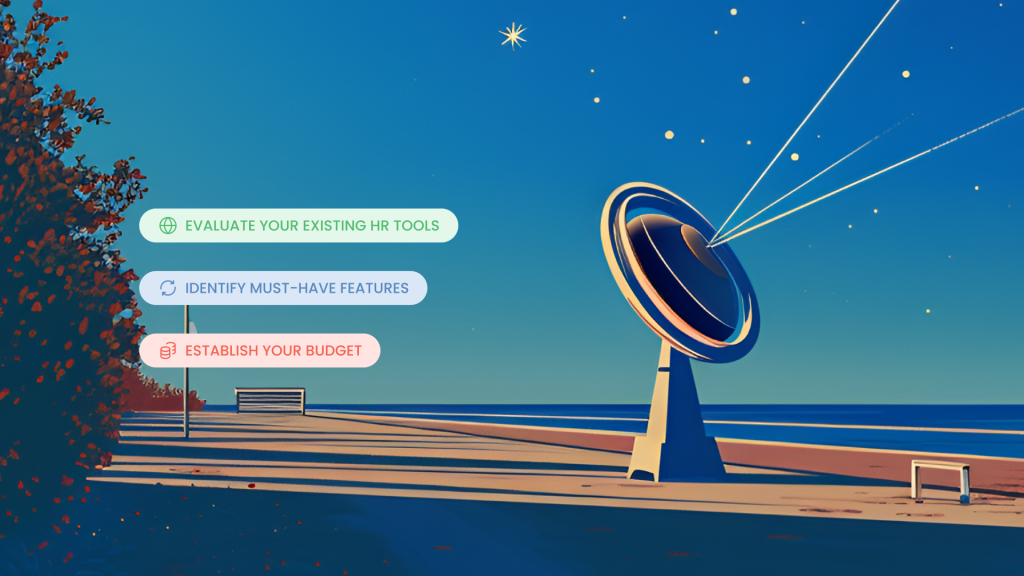The role of HR leaders has expanded greatly since the pandemic. A Gartner survey found that ‘70% of HR leaders say they have more opportunities for impact and 58% report they have more authority to determine strategic priorities.’
How does this translate to your business? The changing landscape requires a change in resources and tools in order to adapt and empower your HR team, which leads us to modern HR software. However, such technology should embody certain functions and features that are suitable and can grow alongside your needs. This article will deep dive into what an HR software is and the key features that it should encompass to meet your needs and empower your team.
What is HR Software?
HR software is a digital system set in place to optimize the performance of employees and managers.
A human resources information system (HRIS), often used interchangeably with HR software, focuses on HR processes and data management. In short, you can turn it into a main source of information fulfilling your employee and management requirements.
Learn more: 5 Reasons to Switch to an All-In-One HR Software
Determining Your HR Needs

Understanding your HR needs is critical for pinpointing the key software features and discovering the most fitting HR solution for your team. This, in turn, leads to higher performance and employee satisfaction levels.
Firstly, assess your current HR system and ask the following questions:
- In which ways is it working?
- In which ways is it not working?
This evaluation will help you identify the strengths and weaknesses of your current HR solution, which offers you valuable insights into the process of choosing another.
Secondly, identify your must-have features. You already know the beneficial features and unmet needs of your current HR software. So, ask yourself: which features can address these pain points? Also, think of your HR goals, and identify which features can help you reach them. This way, you can personalize your must-haves in an HR software tool.
Thirdly, before you search for modules, you need to determine your budget so that you are realistic about your expectations. For this decision, consider various factors including company size, pricing modules (subscription-based plans or perpetual licensing), and required features.
Your HR Software Features Checklist
If you are unsure where to start, refer to our checklist below to choose the features you need in an HR software. This ensures that your investment is optimized for employee satisfaction, productivity, and informed business decisions.
Core HR
As opposed to optional add-ons, core functions are the basic operations or HR responsibilities in HR departments, such as:
- Payroll processing
- Benefits administration
- Employee recruitment scheduling
- Employee training
- Internal relations
- Safety and compliance
A core HR solution manages and streamlines these essential HR functions, acting as a central hub for HR processes and employee database. In short, it becomes the backbone of your business.
Onboarding and Offboarding
As the saying goes, ’first impressions last’, which is why a smooth onboarding process matters. The appropriate HR software ensures new hires have access to important information, including onboarding tasks, employment contracts, and automated software account creations, fostering a seamless onboarding experience.
Additionally, the right HR software plays a valuable role in both onboarding and offboarding by generating paperwork with e-signature options and managing the setup or decommissioning of employee devices, automating the transition process. This ensures employees can quickly focus on their responsibilities, leading to enhanced performance levels, and facilitates a complication-free conclusion to their tenures.
Learn more: How to Evaluate and Choose Employee Onboarding Software in 2024
Performance Management
Modern HR software incorporates performance management modules, which indicates employee performance with data reports, analytics, and annual performance reviews. Aside from traditional annual reports, modern HR software can also support consistent check-ins, templates for performance ratings, and coaching resources for managers.
Effective performance management allows you to effortlessly assess whether employees are efficiently meeting business goals with a simple click. In cases where they may not be, you gain the insights necessary to proactively address potential workflow disruptions.
As modern HR software utilizes key performance indicators (KPIs), this allows for an unbiased method of evaluating employees. Through fair and precise performance reviews, you can determine areas of improvement, administer rewards, and establish performance-based pay systems. By doing so, reap the tangible benefits of performance management in fostering employee development and improving employee engagement.
Employee Self-Service
Modern HR software often incorporates employee self-service (ESS) portals, a highly favored feature. These ESS portals empower employees to conveniently access various information, including payroll information and up-to-date time off and attendance records.
Subsequently, employees can efficiently manage this information by submitting time-off requests, downloading tax forms, adjusting their schedules, or updating personal details – all achievable through various devices, including smartphones.
This not only grants employees flexibility but also alleviates your HR team from the burdens of routine administration, saving time and effort while ensuring the accuracy of employee data.
Payroll and Time Off Management
Your HR software may also double as a payroll management program, relieving your HR team of the administrative burden. It may integrate with your preferred payroll solution or even substitute it entirely. The automation of payroll processing means accurate payroll calculations, automated tax forms, error detection, and error-free financial records, including salaries, benefits, incentives, bonuses, tax liabilities, and deductions. Additionally, employees can log in to view their year-end tax records with ease.
As mentioned previously, employee self-service portals enable employees to request time off directly. The system then registers the request and type of leave (such as annual leave, sick leave or maternity leave), calculating the expected date of return and keeping track of total PTOs to avoid abuse of policies.
Centralized Database
An HR software system with a strong employee record enables HR staff to store as much data as needed via ready-made or customized forms. This database constantly collects and updates all relevant information from spreadsheets, individual documents, and other sources, creating a central source of truth for employee data and records.
This information center can also interact with other features and third-party integrations, further streamlining HR functions. Not to mention, the centralized database facilitates quick and accurate data entry, fast audits, and easy procurement of data, which saves both time and effort, allowing HR teams to focus on other business needs.
Workforce Analytics
Although analytics and reporting are some of the less available features in HR modules, they remain crucial building blocks in HR systems. Fortunately, modern software solutions mitigate this through the use of KPIs and data visualization. These systems leverage data from payroll and performance management modules, and third-party platforms to obtain crucial information and provide a workforce analysis.
With this information, it enables you to precisely evaluate a comprehensive range of aspects, including performance, goals, attendance, employee history, engagement, skill gaps, and turnover rates across all levels of the company hierarchy. As a result, HR teams are able to make informed, data-driven decisions for the betterment of the organization.
Compliance
Choosing an HR software that prioritizes compliance ensures your business aligns with applicable local, state, federal, and international regulations, providing peace of mind and safeguarding against legal complications and penalties. It’s important to note, however, that compliant software is not a replacement for legal or tax expertise.
Modern HR softwares has the capability to generate compliance reports and store documents, like tax forms, for regulatory purposes. If the HR module includes benefits management, it will alert you about the compliance status of your current benefit offerings, ensuring conformity with relevant laws in local or national databases.
Attendance Tracking
If your aim is to enhance productivity, and your HR team is struggling to monitor attendance, opting for software equipped with attendance tracking features can simplify the process. The advantages of using an HR software, including improved data management, streamlined recruitment processes, and enhanced decision-making capabilities, further empower organizations to tackle such challenges effectively.
For example, by integrating attendance tracking software, you may discover patterns such as an employee rarely taking time off, leading to burnout and diminished work ethic, or another employee exploiting the PTO policy and consistently falling short of monthly goals. With this readily available information, you can formulate a strategy to address the issue and subsequently elevate productivity levels.
Which HR Software Features Are Important?
There is no one-size-fits all when it comes to choosing an HR software for your needs. The most important features are the ones that address the main pain points for your HR team, so take it up with them! What are they struggling with? What are your company’s top objectives? Which tools can help you achieve them?
If your aim is to enhance productivity, and your HR team is struggling to monitor attendance, opting for software equipped with attendance tracking features can simplify the process. For example, by integrating attendance tracking software, you may discover patterns such as an employee rarely taking time off, leading to burnout and diminished work ethic, or another employee exploiting the PTO policy and consistently falling short of monthly goals. With this readily available information, you can formulate a strategy to address the issue and subsequently elevate productivity levels.
Omni tip:
Check out those user reviews and take advantage of free trials offered by HR software programs to estimate their suitability for your business!Read next: Your Guide to Successfully Pitching HR Software to Leadership
Navigate Modern HR Challenges with Omni

By evaluating your business needs, researching and trying out different solutions, finding the perfect HR solution for your business needs does not have to be intimidating. Affordable, functional, and suitable for modern businesses — Omni is an HR software that HR teams can count on.
Omni’s fully automated HR platform allows HR teams and managers to create customizable templates that grow alongside your business, molding to each employee’s unique needs and reducing the administrative burden that comes with managing the employee lifecycle. Set up training modules, send automatic reminders, and build personalized communication practices to keep your employees engaged and supported during and beyond their onboarding experience.
To join the 83% of Omni customers who have unlocked new, actionable insights after using our modern HR software solution, book a free demo today.


